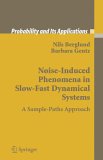|
Noise-Induced Phenomena
in Slow-Fast Dynamical Systems. N. Berglund, B. Gentz |

|
Contents
| 1 | Introduction | 1 | ||
| 1.1 | Stochastic Models and Metastability | 1 | ||
| 1.2 | Timescales and Slow-Fast Systems | 6 | ||
| 1.3 | Examples | 8 | ||
| 1.4 | Reader's Guide | 13 | ||
| Bibliographic Comments | 15 | |||
| 2 | Deterministic Slow-Fast Systems | 17 | ||
| 2.1 | Slow Manifolds | 18 | ||
| 2.1.1 | Definitions and Examples | 18 | ||
| 2.1.2 | Convergence towards a Stable Slow Manifold | 22 | ||
| 2.1.3 | Geometric Singular Perturbation Theory | 24 | ||
| 2.2 | Dynamic Bifurcations | 27 | ||
| 2.2.1 | Centre-Manifold Reduction | 27 | ||
| 2.2.2 | Saddle-Node Bifurcation | 28 | ||
| 2.2.3 | Symmetric Pitchfork Bifurcation and Bifurcation Delay | 33 | ||
| 2.2.4 | How to Obtain Scaling Laws | 36 | ||
| 2.2.5 | Hopf Bifurcation and Bifurcation Delay | 42 | ||
| 2.3 | Periodic Orbits and Averaging | 44 | ||
| 2.3.1 | Convergence towards a Stable Periodic Orbit | 45 | ||
| 2.3.2 | Invariant Manifolds | 47 | ||
| Bibliographic Comments | 48 | |||
| 3 | One-Dimensional Slowly Time-Dependent Systems | 51 | ||
| 3.1 | Stable Equilibrium Branches | 53 | ||
| 3.1.1 | Linear Case | 56 | ||
| 3.1.2 | Nonlinear Case | 62 | ||
| 3.1.3 | Moment Estimates | 66 | ||
| 3.2 | Unstable Equilibrium Branches | 68 | ||
| 3.2.1 | Diffusion-Dominated Escape | 71 | ||
| 3.2.2 | Drift-Dominated Escape | 78 | ||
| 3.3 | Saddle-Node Bifurcation | 84 | ||
| 3.3.1 | Before the Jump | 87 | ||
| 3.3.2 | Strong-Noise Regime | 90 | ||
| 3.3.3 | Weak-Noise Regime | 96 | ||
| 3.4 | Symmetric Pitchfork Bifurcation | 97 | ||
| 3.4.1 | Before the Bifurcation | 99 | ||
| 3.4.2 | Leaving the Unstable Branch | 101 | ||
| 3.4.3 | Reaching a Stable Branch | 103 | ||
| 3.5 | Other One-Dimensional Bifurcations | 105 | ||
| 3.5.1 | Transcritical Bifurcation | 105 | ||
| 3.5.2 | Asymmetric Pitchfork Bifurcation | 108 | ||
| Bibliographic Comments | 110 | |||
| 4 | Stochastic Resonance | 111 | ||
| 4.1 | The Phenomenon of Stochastic Resonance | 112 | ||
| 4.1.1 | Origin and Qualitative Description | 112 | ||
| 4.1.2 | Spectral-Theoretic Results | 116 | ||
| 4.1.3 | Large-Deviations Results | 124 | ||
| 4.1.4 | Residence-Time Distributions | 126 | ||
| 4.2 | Stochastic Synchronisation: Sample-Paths Approach | 132 | ||
| 4.2.1 | Avoided Transcritical Bifurcation | 132 | ||
| 4.2.2 | Weak-Noise Regime | 135 | ||
| 4.2.3 | Synchronisation Regime | 138 | ||
| 4.2.4 | Symmetric Case | 139 | ||
| Bibliographic Comments | 141 | |||
| 5 | Multi-Dimensional Slow-Fast Systems | 143 | ||
| 5.1 | Slow Manifolds | 144 | ||
| 5.1.1 | Concentration of Sample Paths | 145 | ||
| 5.1.2 | Proof of Theorem 5.1.6 | 151 | ||
| 5.1.3 | Reduction to Slow Variables | 164 | ||
| 5.1.4 | Refined Concentration Results | 166 | ||
| 5.2 | Periodic Orbits | 172 | ||
| 5.2.1 | Dynamics near a Fixed Periodic Orbit | 172 | ||
| 5.2.2 | Dynamics near a Slowly Varying Periodic Orbit | 175 | ||
| 5.3 | Bifurcations | 178 | ||
| 5.3.1 | Concentration Results and Reduction | 178 | ||
| 5.3.2 | Hopf Bifurcation | 185 | ||
| Bibliographic Comments | 190 | |||
| 6 | Applications | 193 | ||
| 6.1 | Nonlinear Oscillators | 194 | ||
| 6.1.1 | The Overdamped Langevin Equation | 194 | ||
| 6.1.2 | The Van der Pol Oscillator | 196 | ||
| 6.2 | Simple Climate Models | 199 | ||
| 6.2.1 | The North-Atlantic Thermohaline Circulation | 200 | ||
| 6.2.2 | Ice Ages and Dansgaard-Oeschger Events | 204 | ||
| 6.3 | Neural Dynamics | 207 | ||
| 6.3.1 | Excitability | 209 | ||
| 6.3.2 | Bursting | 212 | ||
| 6.4 | Models from Solid-State Physics | 214 | ||
| 6.4.1 | Ferromagnets and Hysteresis | 214 | ||
| 6.4.2 | Josephson Junctions | 219 | ||
| A | A Brief Introduction to Stochastic Differential Equations | 223 | ||
| A.1 | Brownian Motion | 223 | ||
| A.2 | Stochastic Integrals | 225 | ||
| A.3 | Strong Solutions | 229 | ||
| A.4 | Semi-groups and Generators | 230 | ||
| A.5 | Large Deviations | 232 | ||
| A.6 | The Exit Problem | 234 | ||
| Bibliographic Comments | 236 | |||
| B | Some Useful Inequalities | 239 | ||
| B.1 | Doob's Submartingale Inequality and a Bernstein Inequality | 239 | ||
| B.2 | Using Tail Estimates | 240 | ||
| B.3 | Comparison Lemma | 241 | ||
| B.4 | Reflection Principle | 242 | ||
| C | First-Passage Times for Gaussian Processes | 243 | ||
| C.1 | First Passage through a Curved Boundary | 243 | ||
| C.2 | Small-Ball Probabilities for Brownian Motion | 247 | ||
| Bibliographic Comments | 248 | |||
| References | 249 | |||
| Index | 263 | |||
| List of Symbols and Acronyms | 271 | |||